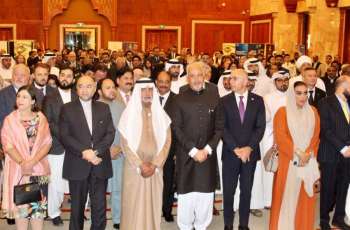Russian President Vladimir Putin discussed with his US counterpart Joe Biden the extension of the bilateral Strategic Arms Reduction Treaty (New START treaty) for the next five years during their first phone call, the Kremlin has confirmed
MOSCOW (Pakistan Point News / Sputnik - 27th January, 2021) Russian President Vladimir Putin discussed with his US counterpart Joe Biden the extension of the bilateral Strategic Arms Reduction Treaty (New START treaty) for the next five years during their first phone call, the Kremlin has confirmed.
Last week, the new US administration announced its intention to seek a five-year extension of the nuclear arms reduction treaty, the latest edition of which was set to expire on February 5. Moscow welcomed Washington's decision. Following phone talks between the countries' leaders on Tuesday, Moscow and Washington announced reaching a relevant agreement without preconditions. Earlier in the day, the Russian lower chamber ratified a bill on the five-year prolongation of the deal.
The New Start Treaty, formally known as the Measures for the Further Reduction and Limitation of Strategic Offensive Arms, was signed by Moscow and Washington in Prague on April 8, 2010, and entered into force on February 5, 2011. It replaced the START-1 treaty, signed on July 31, 1991, and its successive accord, the Treaty of Moscow, which was due to expire in 2012.
Upon the signing of the agreement, Russia also made a unilateral statement on missile defense.
The new START Treaty was drafted on a strict parity basis in accordance with the principle of equal and indivisible security, providing for actual, verifiable, and irreversible reductions in strategic offensive arms.
As a result of such reductions, the total amount of strategic offensive arms available to the parties seven years after the deal came into force (by February 2018) and in the future must not exceed: 700 deployed intercontinental ballistic missiles (ICBMs), deployed submarine-launched ballistic missiles (SLBMs), and deployed heavy bombers (HBs); 800 deployed and non-deployed ICBM and SLBM launchers and HBs; 1,550 warheads on deployed ICBMs, SLBMs and HBs.
The legal limit on the number of warheads in the amount of 1,550 will be different from their actual number due to the fact that the accord set up new rules for counting nuclear warheads carried by heavy bombers, each of which is now assigned one warhead. However, the actual number of warheads that a bomber can carry ranges from 12-24 missiles or bombs depending on the type of bomber in question.
Thus, the actual number of warheads for each party will amount to some 2,100 for Russia and about 2,400 for the United States, which has a slightly greater number of heavy bombers. This difference will decrease as the US B-1B bombers are withdrawn from the nuclear forces and converted for non-nuclear purposes, which will preclude their further use as nuclear weapon-carrying bombers unless these functions are restored following a lengthy process of reconversion.
The treaty imposes no restrictions on the deployment of land-based missiles with multiple independently targeted re-entry vehicles (MIRVs).
The sides are free to determine the structure of their respective nuclear triads (a set of air-, sea- or land-based carriers), and can deploy new types of missiles and other carriers, provided they duly notify each other of such developments.
The agreement prohibits strategic offensive arms from being based outside the national territories of the sides. It does not restrict the development of US missile defense systems, only recognizing a link existing between defensive and offensive weapons.
Besides the treaty, the parties signed a protocol to it, which spells out the terms used in the treaty and establishes new compliance procedures.
The US Senate ratified the treaty on December 22, 2010. Russia's lower parliamentary house, the State Duma ratified the accord on January 25, 2011, while the Federation Council (the upper chamber) ratified it the following day.
On February 5, 2011, Russian Foreign Minister Sergey Lavrov and then-US Secretary of State Hillary Clinton signed a protocol and exchange of instruments of ratification of the treaty in Munich, and it entered into force.
The document was designed to remain effective for 10 years with the potential for renewal for another five years upon the mutual agreement of the parties.
A Bilateral Consultative Commission (BCC), which meets twice a year, was established to address the practical implementation of the treaty. The 18th session of the commission was held in Geneva in November 2019.
By February 5, 2018, the target date set by the treaty, Moscow has fully fulfilled its obligations under the deal. As of this date, Russia's total strategic offensive arms potential included 527 units for deployed ICBMs, SLBMs, and HBs; 1,444 units for warheads on deployed ICBMs and SLBMs, as well as nuclear warheads assigned to deployed HBs; 779 units for deployed and non-deployed ICBM and SLBM launchers, and deployed and non-deployed HBs.
For its part, Washington declared it had reached the total quantitative levels (AMOUNT) of strategic offensive arms (potential) established by the agreement upon the target date. However, the US reached these indicators including through the illegitimate unilateral exclusion from the count of a part of US strategic offensive arms items, declared "re-equipped," namely, 56 Trident-II SLBM launchers and 41 B-52N HBs.
The United States also refused to include in the count four ICBM silo launchers designed for training, which Washington re-identified as "training mines," a category not provided for by the treaty. According to the Russian Foreign Ministry, taking into account these items, the US exceeds the total number of HBs and ICBM and SLBM launchers allowed by the accord by 101 units.
The New Start treaty remains the only existing arms limitation deal between Russia and the United States.
Since 2018, Moscow has repeatedly raised the issue of the extension of the agreement after February 5. The United States said that it was mulling to prolong the accord, but proposed to broaden it to a larger range of new weapons, not included in the current treaty. Besides, Washington voiced a suggestion to invite China to join the agreement. Beijing said it was not interested in such an initiative.
On October 10, 2020, US Special Envoy for Arms Control Marshall Billingslea reportedly said that Washington was ready to extend the New Start treaty the next day in exchange for a mutual freeze of nuclear arsenals, believing it reached an "agreement in principle" with Moscow on the matter. Russian Deputy Foreign Minister Sergei Ryabkov said that Moscow has been long aware of the US stance on the freezing of nuclear arsenals regarding the conclusion of a potential arms reduction agreement, adding that it was unacceptable to Russia.
On October 16, 2020, the Russian leader proposed to extend the current New Start treaty without any conditions for a year.




